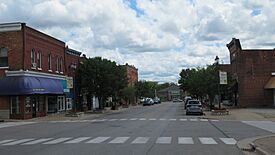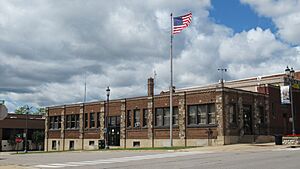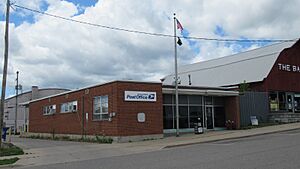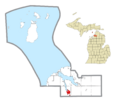East Jordan, Michigan facts for kids
Quick facts for kids
East Jordan, Michigan
|
|
|---|---|
| City of East Jordan | |

Looking north along Main Street
|
|
| Motto(s):
"Where River, Lake, and Friendly People Meet"
|
|

Location within Charlevoix County
|
|
| Country | United States |
| State | Michigan |
| County | Charlevoix |
| Settled | 1873 |
| Incorporated | 1887 (village) 1911 (city) |
| Government | |
| • Type | City commission |
| Area | |
| • Total | 3.92 sq mi (10.15 km2) |
| • Land | 3.00 sq mi (7.77 km2) |
| • Water | 0.92 sq mi (2.38 km2) |
| Elevation | 646 ft (197 m) |
| Population
(2020)
|
|
| • Total | 2,239 |
| • Density | 746.33/sq mi (288.19/km2) |
| Time zone | UTC-5 (Eastern (EST)) |
| • Summer (DST) | UTC-4 (EDT) |
| ZIP code(s) |
49727
|
| Area code(s) | 231 |
| FIPS code | 26-24020 |
| GNIS feature ID | 0625200 |
East Jordan is a city located in Charlevoix County, in the U.S. state of Michigan. In 2020, about 2,239 people lived there.
The city sits at the very end of the south arm of Lake Charlevoix. It is also where the Jordan River flows into the lake. A big international company called EJ has its main office in East Jordan. This company, once known as East Jordan Iron Works, started in the city in 1883.
Contents
History of East Jordan
The area where East Jordan is today was first settled in 1873 by William Empey from Canada. He built the first store in 1874 right where the Jordan River meets Lake Charlevoix. Empey also became the first postmaster when a post office opened in 1878.
The community grew and joined with a nearby village called South Arm. It officially became the village of East Jordan in 1887. Later, in 1911, it became a city.
East Jordan grew quickly, especially because of the large ironworks company, now known as EJ, which started in 1883. The city had two railroad connections, which helped it ship goods easily. With these railroads and the ability to use Lake Charlevoix to reach Lake Michigan, East Jordan became an important manufacturing center. Even today, four industrial companies still operate in the town.
Two important buildings in East Jordan are listed on the National Register of Historic Places. These are the East Jordan Lumber Company Store Building and the Votruba Block. Both were built in 1899 and are found close to each other in the city's downtown area.
Geography of East Jordan
According to the U.S. Census Bureau, East Jordan covers a total area of about 3.92 square miles (10.15 square kilometers). About 3.00 square miles (7.77 square kilometers) of this is land, and 0.92 square miles (2.38 square kilometers) is water.
The city's boundaries include a separate piece of land where the East Jordan City Airport is located. This airport is southeast of the main part of the city.
Major Roads in East Jordan
- M-32 comes into the city from the east. It ends in East Jordan where it meets M-66.
- M-66 runs from south to north through the western part of the city.
- C-48 is a county road that goes through the center of the city. For a short distance, it runs along with M-32.
East Jordan's Climate
East Jordan has a climate with big changes in temperature throughout the year. Summers are warm to hot and often humid. Winters are cold, and sometimes very cold. This type of climate is known as a humid continental climate.
Population of East Jordan
| Historical population | |||
|---|---|---|---|
| Census | Pop. | %± | |
| 1890 | 731 | — | |
| 1900 | 1,205 | 64.8% | |
| 1910 | 2,516 | 108.8% | |
| 1920 | 2,428 | −3.5% | |
| 1930 | 1,523 | −37.3% | |
| 1940 | 1,725 | 13.3% | |
| 1950 | 1,779 | 3.1% | |
| 1960 | 1,919 | 7.9% | |
| 1970 | 2,041 | 6.4% | |
| 1980 | 2,185 | 7.1% | |
| 1990 | 2,240 | 2.5% | |
| 2000 | 2,507 | 11.9% | |
| 2010 | 2,351 | −6.2% | |
| 2020 | 2,239 | −4.8% | |
| U.S. Decennial Census | |||
In 2010, there were 2,351 people living in East Jordan. There were 952 households, and 613 families. The city had about 770.8 people per square mile.
Most of the people living in East Jordan were White (96.0%). A small number were Native American (1.6%) or from other backgrounds. About 2.3% of the population was Hispanic or Latino.
About 35.6% of households had children under 18 living with them. The average age in the city was 37.1 years old. About 27.1% of residents were under 18.
Education in East Jordan
East Jordan has its own school system called East Jordan Public Schools. These schools are located in the city and serve students from several nearby townships as well.
Images for kids
See also
 In Spanish: East Jordan para niños
In Spanish: East Jordan para niños







